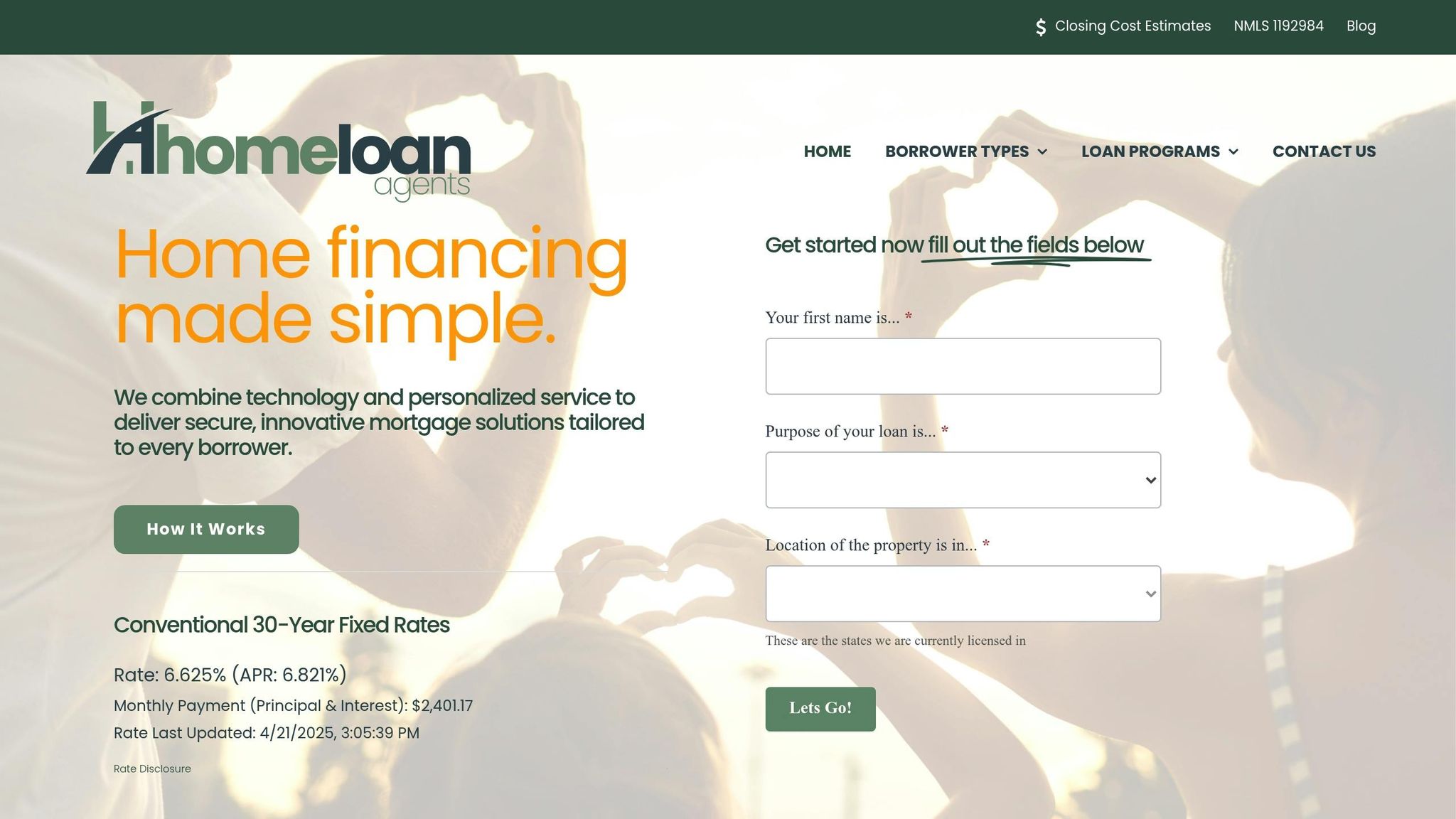Mortgage rates have climbed significantly, from under 3% in 2021 to over 5.5% today, making homeownership more expensive. Here’s how to protect your finances and make smart decisions in this environment:
- Understand the Impact: Higher rates increase monthly payments and total borrowing costs. For instance, a $300,000 loan at 5.5% costs $370 more per month than at 3%.
- Negotiate Smartly: Use seller concessions for rate buydowns or closing-cost swaps to reduce your upfront or long-term costs.
- Lock Rates Strategically: Secure a rate lock to avoid market fluctuations, but compare lenders and terms before committing.
- Choose the Right Mortgage: Fixed-rate loans offer stable payments, while adjustable-rate mortgages (ARMs) may save you money if you plan to move sooner.
- Monitor Market Trends: Watch Treasury yields, inflation data, and Federal Reserve announcements to time your rate lock effectively.
- Improve Your Finances: Lower debt, boost savings, and get preapproved to qualify for better rates.
Effects of Higher Mortgage Rates
Calculating Payment Changes
Since early 2021, average 30-year fixed mortgage rates have more than doubled, making homes harder to afford. To put it into perspective, a 2-percentage-point increase in rates adds about $115 per $100,000 to your monthly payment. For a $300,000 loan, that means an extra $370 each month when rates rise from 3% to 5% [2].
Current Market Effects
Higher rates impact the market in two key ways:
- Reduced buying power: Rising rates lower the loan amount you can qualify for based on your budget [3].
- Tighter qualification standards: Higher rates increase debt-to-income ratios, making it harder to get approved for a loan [2].
Next, learn how to secure a good rate and compare offers to find the best mortgage terms.
Maximize Your Mortgage Strategy: Rate Lock Tactics Revealed
Getting Better Mortgage Terms
Now that you’ve seen how rising rates can impact your budget, the next step is securing better terms through a strategic rate lock and comparing lenders side by side.
Understanding Rate Locks
A rate lock protects you from fluctuations in interest rates between the time you sign a contract and when you close on your home. This can be especially helpful in volatile markets, like when rates jumped from about 6.8% to 7.3% in April 2024 [4].
"If you find a house you love and you are comfortable with the payment on the home based on today’s rates, we suggest locking that rate so you have certainty of what your payments will look like on your home loan." – Sean Grzebin, Head of Consumer Originations at Chase Home Lending [4]
Rate lock periods generally last 15 to 60 days. Longer locks may come with higher fees, and if your closing date goes beyond the lock period, you might face a 0.25% extension fee. Some lenders also offer a float-down option, allowing you to benefit from lower rates if they drop during your lock period, though this typically costs extra [4].
Comparing Rates Effectively
Online mortgage calculators are a great way to compare monthly payments for different rate and term combinations. Once your rate is locked and you’ve reviewed multiple offers, you can move on to exploring mortgage types and additional ways to save money.
sbb-itb-8115fc4
Mortgage Types and Money-Saving Tips
Once you’ve compared offers and secured rates, it’s time to pick the mortgage type and decide on a buydown approach that helps guard against future rate increases.
Fixed vs. Adjustable Rates
The type of mortgage you choose determines how well you’re protected from rate changes. Fixed-rate mortgages offer stable payments throughout the loan term, while adjustable-rate mortgages (ARMs) start with lower rates but can increase after the initial fixed period [7].
Key Differences:
- Fixed-rate mortgages: Payments stay the same, come with a higher starting rate, and work well for long-term plans.
- Adjustable-rate mortgages: Start with a lower rate, but payments may change later, making them better for short-term ownership.
- Risk factor: Fixed-rate loans are less risky, while ARMs come with more uncertainty.
- Popularity: Roughly 90% of buyers opt for fixed-rate mortgages [7].
Using Rate Buydowns
Rate buydowns can reduce your interest rate at the time of closing. In 2023, nearly 60% of buyers and 90% of refinancers used this strategy [5].
Permanent Buydowns (Discount Points)
For a $300,000 mortgage at 6.5%, paying one discount point (1% of the loan amount) can lower your rate by about 0.25%. This would break even in about 6.4 years and save you approximately $14,000 over 30 years [5].
Temporary Buydowns
A common 2/1 buydown on a $400,000 loan might cost around $9,000 [5].
"Most borrowers only benefit from discount points if they keep their mortgage long enough that the cumulative monthly savings from the reduced interest rate outweigh the upfront costs." – Consumer Financial Protection Bureau [5]
Money-Saving Tips:
- Figure out your break-even point to ensure the buydown makes financial sense.
- Negotiate seller concessions to cover buydown costs, making sure contributions stay within program limits [5][6].
Next up, we’ll dive into how to interpret market trends and improve your financial profile to lock in better rates.
Market Timing and Financial Planning
Reading Market Signals
Mortgage rates can change daily, so understanding key indicators can help you decide when to lock in your rate.
Best Days to Lock Rates:
- Mondays: Typically the most stable, with average changes of 17.3 basis points.
- Wednesdays and Fridays: More unpredictable, with average fluctuations of 23.8 and 23.6 basis points, respectively. [8]
Key Economic Indicators to Watch:
- Federal Reserve FOMC Meetings: Held every sixth Wednesday, these meetings directly impact rates.
- Non-Farm Payrolls: Released monthly on the first Friday, this report often triggers market volatility.
- Consumer Price Index (CPI): A monthly snapshot of inflation trends.
- 10-Year Treasury Yield: A daily indicator that influences mortgage rates.
Tips for Tracking Rates:
- Keep an eye on mortgage-backed securities (MBS) prices – they tend to move in the opposite direction of rates.
- Pay attention to Federal Reserve announcements, especially regarding monetary policy.
- Monitor inflation reports, particularly when inflation is near the Fed’s 2% target. [9]
By timing your rate lock around these factors, you can better protect yourself from sudden rate increases.
Improving Your Rate Eligibility
Once you’ve identified market trends, focus on strengthening your financial profile to secure the most favorable rate.
- Reduce high-interest debt: This improves your debt-to-income ratio. [1]
- Lower your monthly obligations: Cutting down overall debt can make a big difference.
- Look into local assistance programs: Many offer support with down payments, closing costs, or even reduced rates. [1]
- Show financial readiness: Prepare a preapproval letter and gather documentation proving you have the funds for your down payment. [1]
Combine these financial improvements with market insights to pinpoint the best moment to lock in your rate. Keep in mind that Federal Reserve policies heavily influence mortgage rates, especially when inflation approaches or surpasses their 2% benchmark. [9]
HomeLoanAgents‘ Mortgage Services
HomeLoanAgents brings together rate-protection options and customizes them into mortgage solutions designed to fit your needs.
Available Loan Programs
You can lock in your rate or reduce costs with these loan options:
- Fixed-Rate Mortgages: Offers stability with flexible lock periods.
- Adjustable-Rate Mortgages: Provides lower initial rates for short-term savings.
- FHA Loans: Requires just 3.5% down and offers competitive rates.
- VA Loans: Zero down payment and discounted rates for eligible veterans.
- DSCR Loans: Focuses on income-based qualification, ideal for property investors.
Digital Mortgage Tools
HomeLoanAgents’ digital tools help speed up the process and keep you in the loop:
Automated Underwriting and Verification
- Verifies income and assets digitally.
- Delivers fast approval decisions.
Secure Application Dashboard
- Offers real-time updates on your application.
- Allows secure document uploads and instant notifications.
These tools ensure you can lock in your rate and finalize your mortgage without unnecessary delays.
Customer Service and Compliance
HomeLoanAgents operates as a licensed partner of Home Mortgage Alliance Corporation (HMAC) in CA, AZ, NV, WA, OR, CO, TX, FL, WI, and ID. They comply with all state and federal regulations. Whether you prefer a fully digital experience or guidance from an advisor, their team provides personalized support.
Up next, learn how these tools and loan programs simplify your closing process.
Conclusion: Steps for a Smart Purchase
Now that you’re equipped with strategies for market timing and eligibility, here’s how to wrap up your purchase:
Focus on negotiating rates, sticking to your budget, and submitting a strong loan application to set yourself up for success.
"If the right house comes along and the payment is affordable (even if you don’t like the interest rate), you should buy the house." – David Kuiper, vice president and senior mortgage banker for Dart Bank in western Michigan [1]
Key Steps to Finalize Your Purchase:
- Negotiate with the seller to cover temporary rate buydowns.
- Lock in the best rate available for your loan program at the right time.
- Prioritize your monthly payment over just the interest rate to stay within your budget.
- Strengthen your loan application by reducing debt, maintaining steady employment, securing preapproval, and submitting all required documents early.
Related posts








